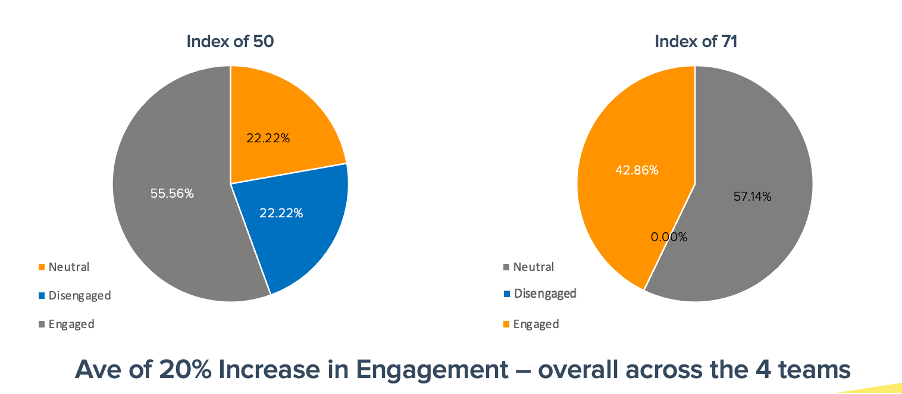Practicing EQ gives you a win-win outcome.
Inherently, we all know emotional intelligence (EQ) is a driver for high performance and a catalyst for personal success.
However, there’s no better reassurance than having the hard data to back-up those instincts, and so we set out to test a theory: we believed that harnessing and practicing EQ provides a cyclic ‘win-win’ both for teams as an entity, and for the individuals within them. It’s a circle of success.
OUR APPROACH
To do this exercise, we engaged with four different organisations who were happy for us to record our work, coaching four existing teams. The objective was to help each one of them increase their team’s performance, coaching and focusing on emotional intelligence.
Each team received four half days of emotional intelligence coaching; each individual received a personal coaching session too, spread over a four-month period. We rigorously measured the impact of our interventions, confident a change in emotional intelligence would have a cyclic, ripple effect – helping each team, providing a positive outcome for the individuals, too.
From the outset, we had three hypotheses:
- Encouraging team members to practice their emotional intelligence would have a positive impact on team performance.
- Overall engagement among team members would improve as a result of this EQ work.
- And the EQ of the individuals themselves would increase through our coaching.
EQ RESULTS – 1
We used the Six Seconds Team Vital Signs measure of team performance, both before and after the coaching. Aggregated scores demonstrate the positive shifts; you can see the red vertical line in these graphs, which indicates the norm, and in all five measures, the teams’ performance improved in every area – exceeding the global norm.
Team performance improved through emotional intelligence coaching.

EQ RESULTS – 2
These charts show the aggregate engagement scores for all four teams. Four months after the first intervention, none of the individuals were identifying or demonstrating disengagement at all, and the overall level of engagement had doubled from 22% to 43%.
ENGAGEMENT IMproved ACROSS ALL FOUR TEAMS.

EQ RESULTS – 3
By contrast, the black line on this chart represents the results for four control teams who did not receive EQ coaching. The yellow line shows the four coached teams’ EQ before and after the coaching – a very reassuring outcome.
The emotional intelligence quotient increased for all 4 coached teams.

What’s more, there were other positive outcomes from this work. We saw distinct increases in Reflexivity and Creativity scores through the same EQ coaching sessions, and the teams’ feedback makes for interesting reading.

Greengrass – EQ – what HAVE WE PROVED?
So, why was this work important – and what do our findings mean for HR leads, Learning & Development teams, and leaders or senior executives in a transformation role?
In short, we have proved that EQ works.
EQ is a means to unlock problems. EQ competencies are learnable, and practicing EQ impacts performance positively. People are starved of this type of learning, but it’s highly fulfilling work – and it’s work that delivers a win-win, for both the business and (on a personal level) for the individuals involved.
Albert Einstein said, “Insanity is doing the same thing over and over again and expecting different results”. Practicing EQ is a learned application, and EQ coaching is something we offer on a consultative basis – either as a standalone service or as a component part of our teams’ development work.
Want to find out more about EQ?

